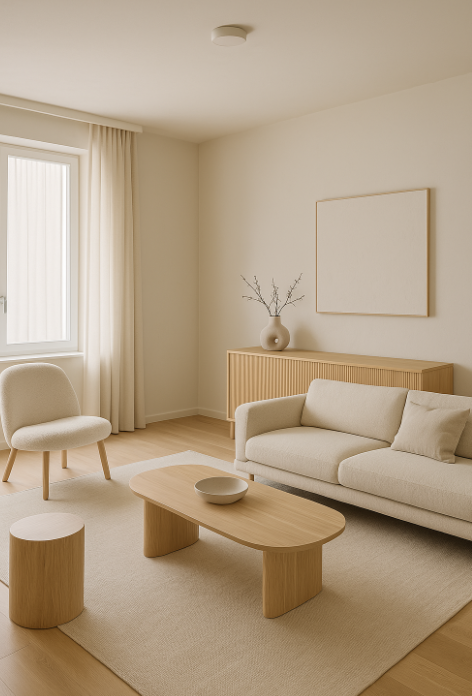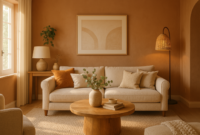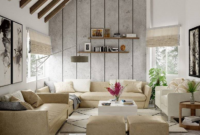Latest Minimalist Home Interior Design
In a world increasingly saturated by noise, clutter, and chaos, the allure of minimalist interior design has never been stronger. Rooted in the principle of “less is more,” minimalist design creates a serene, harmonious space that champions simplicity, function, and beauty. The latest trends in minimalist home interior design are a fresh evolution of this timeless aesthetic, blending subtle warmth, sustainable materials, and smart technology with pared-down elegance. Let’s explore what defines the current wave of minimalism and how you can incorporate it into your home.
The Essence of Modern Minimalism
At its core, modern minimalist interior design emphasizes clean lines, neutral palettes, uncluttered spaces, and purposeful placement. However, unlike the cold, ultra-modern minimalism of the past, today’s interpretation introduces a softer, more livable feel.
Gone are the days when minimalism was synonymous with stark white walls, uncomfortable furniture, and an unwelcoming austerity. The current trend embraces cozy textures, muted tones, and natural elements that create a warm, inviting ambiance while still maintaining a clutter-free look.
Key Characteristics:
-
Neutral but Warm Color Schemes: While white still reigns supreme, modern minimalist interiors now lean into warmer neutrals like ivory, taupe, stone gray, and soft beige. These tones lend an organic, soothing feel to the space.
-
Natural Materials: The use of wood, stone, linen, rattan, and clay adds texture and life to minimalist spaces. These materials connect the indoors with the natural world and help create depth without adding visual clutter.
-
Functional Furnishings: Every piece in a minimalist room must have a purpose. Dual-purpose furniture (like ottomans with storage), sleek modular sofas, and low-profile tables dominate the space with elegance and function.
-
Open Spaces: Open layouts are integral to minimalist design, offering unbroken sight lines and a feeling of expansiveness. Clear spaces between furniture allow for ease of movement and breathability in design.
-
Light & Shadow: Lighting is used thoughtfully—both natural and artificial. Large windows, sheer curtains, and subtle ambient lighting work together to soften the space and enhance its simplicity.
Living Room Minimalism: The New Cozy Core
The living room is the heart of any home, and in minimalist design, it becomes a sanctuary. The latest designs steer toward earth-toned furniture, layered textures, and curated accessories.
Trending Elements:
-
Neutral Modular Sofas: Configurable pieces with clean lines that can adapt to the room’s layout.
-
Soft Rugs in Subtle Patterns: Wool or jute rugs in subdued designs add comfort without overwhelming.
-
Statement Art: A single large abstract painting or black-and-white photograph becomes the focal point, replacing gallery walls.
-
Low, Wide Coffee Tables: Typically in wood or stone, providing utility with style.
Instead of overcrowding the space with décor, designers recommend one or two accent pieces—like a tall plant or a sculptural lamp—that add personality without disrupting the calm.
Kitchen: Sleek, Seamless, and Smart
Modern minimalist kitchens are a blend of sleek design and smart technology. Handleless cabinetry, integrated appliances, and seamless countertops are in vogue.
Essentials:
-
Matte Finishes: Cabinets and hardware in matte black, soft gray, or white create a smooth, uninterrupted surface.
-
Hidden Storage: Pull-out pantries, appliance garages, and under-counter storage keep countertops free of clutter.
-
Smart Appliances: Ovens, fridges, and lighting systems that can be controlled remotely streamline the kitchen experience.
-
Open Shelving (in moderation): Instead of overcrowded shelves, a few curated items—like handmade pottery or a vase—give warmth without clutter.
Minimalist kitchens also emphasize cleanliness and hygiene, which fits well with the design’s emphasis on tidiness and order.
Bedroom: Serenity Through Simplicity
The bedroom in a minimalist home serves as a retreat from the overstimulation of daily life. The goal is to foster tranquility and restfulness.
Design Priorities:
-
Low Bed Frames: Platform beds with hidden storage promote a grounded, calming energy.
-
Monochrome Bedding: White, ivory, or pale gray linens in high-quality natural fabrics (linen, cotton) enhance the tactile experience.
-
Floating Nightstands: Minimal in size and shape, often paired with wall-mounted lights.
-
No Excess: Everything visible in the bedroom must have a purpose. Even décor pieces serve a function—such as blackout curtains, weighted blankets, or calming art.
Personal touches like a favorite book, a scented candle, or a potted plant are welcome, but they’re carefully curated and spaced.
Bathroom: The Spa-Like Oasis
Minimalist bathrooms take inspiration from spa environments—calm, clean, and cohesive. Natural stone, soft lighting, and uncluttered surfaces are key.
Common Features:
-
Wall-Mounted Vanities: These create a floating effect, making small bathrooms feel more open.
-
Large Mirrors with Backlighting: Enhance the feeling of spaciousness.
-
Neutral Tiles: Think large-format tiles in light gray, beige, or stone, sometimes with subtle texture.
-
Open Showers: Frameless glass doors or even walk-in showers without doors maximize space and reduce visual barriers.
Greenery, like a small fern or eucalyptus in a minimalist vase, adds life to the space without disrupting the design.
Minimalist Color Psychology
Color plays a vital role in the new wave of minimalism. The trend leans into “emotional minimalism,” where each color and texture contributes to a feeling of peace, safety, or wellness.

Popular Color Pairings:
-
Soft Beige & Warm White: Creates warmth while keeping things bright.
-
Charcoal Gray & Natural Wood: Offers contrast with a sense of groundedness.
-
Sage Green & Cream: Brings in a hint of nature and calmness.
-
Terracotta Accents with Taupe: Adds an earthy, Mediterranean warmth.
These combinations are often used in small doses—perhaps one wall, one piece of furniture, or an accent pillow—to subtly influence the room’s mood.
Decluttering as a Design Practice
In minimalist homes, decluttering is not just an organizational task—it’s a design strategy. Items are removed, not merely hidden. Every object is questioned: does it serve a function or spark joy?
Strategies for Maintaining Minimalism:
-
The One-Touch Rule: Everything you interact with daily should be easy to access and return.
-
Conscious Purchasing: Buy only what you truly need or love. Quality over quantity.
-
Daily Resets: A quick tidy-up each evening maintains the minimalist aesthetic effortlessly.
-
Digital Declutter: Today’s minimalism extends to visual noise from tech. Smart home screens are sleek and often hidden when not in use.
Minimalism with Kids and Pets
One of the criticisms of minimalist design is that it’s impractical for families. But the latest approach addresses this. It includes child-friendly furniture, pet-safe fabrics, and closed storage for toys and gear.
Solutions:
-
Rounded Edges: Softer lines in furniture reduce hazards.
-
Performance Fabrics: Stain-resistant yet stylish, perfect for high-traffic areas.
-
Zoned Spaces: A small minimalist play area or reading nook can blend with the main living area through consistent color and design.
Minimalism is not about eliminating life—it’s about supporting it in an intentional, beautiful way.
The Role of Technology
Smart home integration has become an integral part of the minimalist design. Touchless lighting, built-in speakers, underfloor heating, and voice-controlled appliances offer luxury without visual excess.
In newer minimalist homes, tech is invisible. Wires are hidden, charging docks are built-in, and thermostats are flush with the wall.
Sustainable Minimalism
Sustainability is a key pillar in the latest minimalist trends. This includes:
-
Eco-Friendly Materials: Recycled woods, bamboo, cork, and reclaimed stone.
-
Energy-Efficient Design: Large windows for natural light, passive cooling, and energy-saving appliances.
-
Longevity Over Trends: Choosing timeless pieces that last longer and avoid waste.
A minimalist home is not just an aesthetic choice—it’s an ethical one.
Final Thoughts
The latest minimalist home interior design movement is more than just a trend—it’s a lifestyle. It’s about living with intention, reducing excess, and creating a home that supports clarity, calm, and connection. The beauty of this new wave of minimalism lies in its flexibility: it can be soft or sleek, earthy or elegant, urban or rustic. Whatever your style, minimalism offers a chance to slow down and savor the space you live in.
By combining the aesthetic of simplicity with the comforts of modern living, minimalist design proves that less can indeed be so much more.


